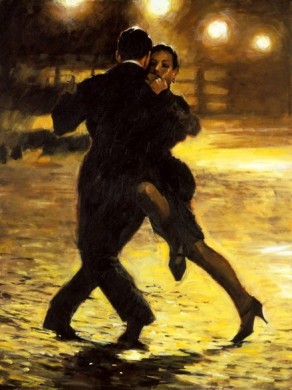
You leave the cobbled streets of San Telmo with its yellow gas-like street lamps and walk up the stairs, letting your fingers run across the rough surface of the brick wall. There will be no more roughness past the double door at the top of the stairs.
You enter the milonga and pay your entrance. Arming yourself with a glass of red wine, you sit down at one of the tables surrounding the dance floor. A handful of couples are already dancing, locked inside the private world of their embrace and quite unaware of your jealous gaze. You want what they have. The memory of that embrace is what brings you back to the milonga, night after night, like a restless spirit.
You sip your wine and scan the crowd. Most of the faces are familiar to you. You look forward to their embrace as a friend to another, but tonight, romance stirs in your restless heart and your eyes keep searching until— there. A vision of Elegance, alone at a table across the dance floor. Elegance looks back at you and your heart skips a beat. “Calm,” you whisper to yourself as you hold the gaze. It is like holding a live wire! You count, “One, two, three,” and then nod. Elegance smiles back at you. A deal has been struck!
You both stand up and walk to meet each other at the dance floor where, without a word, you embrace. Nothing Elegance could say would be more important than this embrace. The dance begins, searching at first but rising steadily with the music to a frenzied crescendo where every drifting foot, exposed thigh or spread leg is exploited and played with!
Welcome to Tango.
History
Tango was created by the poor lower-class immigrant workers of Buenos Aires. They brought with them the choreographed ‘new’ couple dances of Europe, like the Viennese Waltz, but replaced the choreography with a daring new leader/follower improvisation. Throw in a few other influences, like the African candombe, and you get tango! (See this comment for a correction on this paragraph.)
Tango was not invented in brothels, as many believe, but they are connected. Immigration was dominated by men, and so the male-to-female ratio was skewed so far that men turned to brothels in such numbers that they had to wait their turn. To entertain the waiting customers, the brothels hired music bands playing the tango and the men danced together, practising for when they would dance with a girl for whom they hadn’t paid. This is where middle class first encountered tango.
Tango had to be exported to Paris and then re-imported for it to become publically acceptable to the Argentine middle class. During this gentrifying boomerang tour, the lyrics went from bawdy crude my-dick-is-bigger-than-yours type of self-aggrandising (think modern day rap) to the romantic poetry that we know today. This was the golden age of tango where everyone except the upper classes danced tango.
The coup of 1955 ended the golden age. The new regime, mainly influenced by the upper classes, hated tango as much as (and probably because) the old regime loved it. Tango was forced underground where it remained until 1983 when the military junta fell.
Tango enjoys a renaissance since then, but much of the golden age traditions and steps were lost. However, in its place, new steps and traditions took root, leading among other things to Tango Nuevo.
In 2009, UNESCO accepted tango as a UNESCO Intangible Cultural Heritage, and I think it well deserves it!
Let’s Dance!
Some say that tango is ‘just walking’. They are clearly insane, and you should pay no attention to them. What they may be alluding to, however, is that the basic steps of tango are simple walking steps (forwards, backwards, sidesteps) and pivots. However, just as the basic moves of chess pieces may be simple to learn but mastering the game is a lifelong process, so it is with tango.
A common misconception of tango is that it is choreographed. It is an easy mistake to make since the legwork seems too intricate to be improvised, but improvised it is! (With the exception of show tango.) The leader guides the follower through dazzling chains of steps, and each link is decided upon in the last moment. The leader leads the follower using only the embrace, and the follower must react as quickly and decisively as the leader leads. No wonder that the expression of tango dancers is one of grim concentration! This is hard work, and I have seen dancers change out of their sweaty shirts twice in a night!
Tango is danced at dance clubs knows as milongas. They are often small, intimate places, dominated in the middle by the dance floor. Around the dance floor are small tables with a few chairs each. There the milongueros (dancers) sit with their red wine in small clusters of friends and watch the dance.
Tango is danced in sets of four songs called tandas, and you stay with the same partner for the remainder of the tanda. If your partner thanks you and return to his place before the tanda is over, you should feel entirely, thoroughly and completely discarded, disregarded and discouraged from ever asking that person for another dance.
Tandas are separated by cortinas, a non-tango song (rock, swing, samba etc). This is the time to get something from the bar or, more importantly, find a willing victim for the next tanda. There is a codified way of doing the latter called the cabeceo. The man catches the eye of the woman he wants to dance with and gives a little nod. If she returns the gaze with a smile, they both get up and get busy. If she pretends not to have seen the now heartbroken man, then best of luck with the next girl. I love the idea of the cabeceo, but I didn’t see it used in practice. Perhaps I hung out with the uncouth lowlife of Buenos Aires, but people generally just tapped me on the shoulder and said, “Quieres?”
What makes the atmosphere at a milonga so special is that the dance is, both figuratively and literally, at the centre of things. You drink and chat with your friends like any other bar or club, but the main business of the night is the dancing. I’ve enjoyed milongas where I missed only a few tandas, blissfully remaining on the dance floor for most of the night.
Queer Tango
You lead tango with your torso. You follow with your heart. Unless you are a fantastical freak of nature, you have both torso and heart, and thus can both lead and follow, no matter if you are male or female.
Queer tango divorces the leader/follower roles from the gender. This of course makes the dance more suitable for the LGBT community, but queer tango is not synonymous with gay tango. There are plenty of straight people in queer milongas. They just enjoy both sides of the dance.
Historically, this is not too far from the origins of the dance. Men would learn to follow before they learned to lead, and they maintained their following skills, but only with other men during their established practice sessions. There is a long and fascinating story behind this involving men waiting around in brothels and a warped male-to-female ratio, but it is too long to retell here.
The fact remains, however, that knowing how to follow makes you a better leader, and vice versa.
Learning Tango
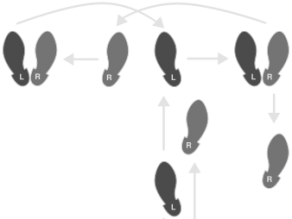
During the golden age of tango, a man would learn to follow for nine months before learning to lead, and would only be accepted into the milongas after about three years! Modern milongas are much more forgiving.
It is still a difficult dance to learn, but if you visit Buenos Aires for a few months, you don’t have a choice. You have to. Yes, that’s right. You have to learn the tango, for no other reason than that it would be an unforgivable shame to squander the opportunity.
You can learn tango in two places. The first are private classes, either one on one with a teacher or in a small group. The second is at the milongas, which often have classes for all levels before the real dancing starts. Once the real milonga gets started, expect to sit and watch a lot until you get good enough to navigate the floor. (A good reason to take some private classes!)
Tango for Nomads
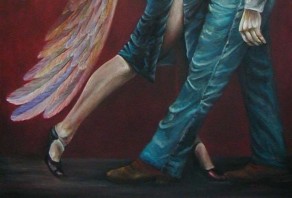
You don’t just learn to dance when you pick up tango; you also make new friends. There is a circuit of queer milongas followed by the same people, week after week. You’ll quickly become friends with these milongueros, and as a freshly arrived nomad in Buenos Aires, there is no better place to make friends. I have no reason to think it any different for non-queer milongas.
During my months here, I met many part-time nomads who, like migrating birds, leave Europe each winter to fly to Buenos Aires where they tango for a few months before returning to their native country. These part-time nomads were the most fanatic tango enthusiasts conceivable. They would take several classes per day, every day, and then rush to a milonga in the evening.
Some of these part-time nomads fell so deeply in love with tango that they unpacked their bags permanently and settled down. I can see why. It is tempting. The dance is very seductive indeed.
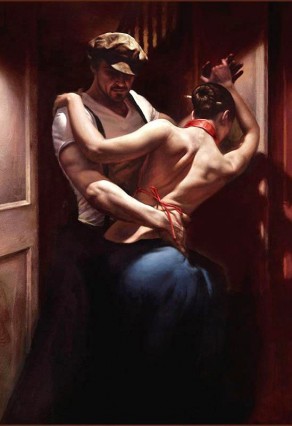
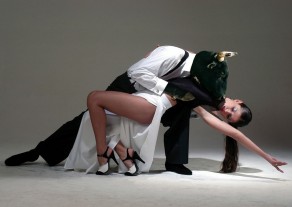
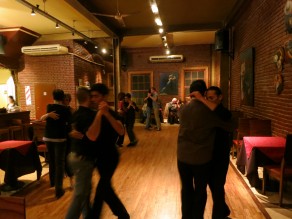
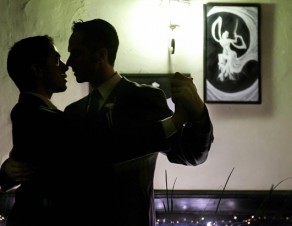


It sounds a great culture to be a part of, and so expressive too. I couldn’t agree more with your comments about the clubbing scene monopolising ‘going out’, but I guess here in the UK we like to be sheep – possibly moreso away from the capital. We like our housing estates of identical homes filled with identical consumer goods, our regular 9-5 jobs, reality television in the eveings and then our pubs and clubs at the weekend. Why are we so scared of being individuals these days?
As you pointed out, I never realized the tango was improvised. I always assumed it was finely choreographed.
It appears you are a good student, as your moves are very smooth in the video. Congratulations!
Gorgeous. I love dancing. The Lithuanian polka is exactly the same in Latvia. Thanks for this
Sveiks, Māri,
He, Gustavs nez kāpēc mani ir nokristījis par lietuvieti;-) Interesanti, ka ir vairāk par vienu latvieti, kas lasa viņa blogu. Kā jau mums pieņemts: jebkuriem diviem latviešiem, ja viņi nav personīgi pazīstami ir vismaz viens kopīgs draugs vai paziņa. Mūsu gadījumā tas ir zviedrs (bet gan jau, ka ir arī kāds latvietis).
Priekā un lai veicas,
Arts
I hang my head in shame; I made a mistake and wrote ‘Lithuanian Polka’ instead of ‘Latvian Polka’, and Arturo comes from the latter country and no where else.
Corrections have been made throughout.
Ahhhhh, for technicality, the pros win, for SENSUALITY, Gustav wins !
I totoly agre Crys.
¡Me encanta tu artículo de tango! ¿Lo puedo robar para publicarlo en mi blog de tango (sin traducción)?
Je, una cosa: ¿de dónde, después de tantos meses de conocimiento salió Lituania y lituano? Soy letón de Letonia, che (lo mismo que Vals 😉
Y de lo de cabeceo: no es tan popular en La Marshall y Tango Queer como en las milongas muy tradicionales, pero, sí, se practica el cabeceo en La Marshall también. Es tan sutil que probablemente no lo hayas visto. ¿Te enseño hoy por la noche?
Besos y nos vemos pronto,
A.
Gustav, I do not think you made a mistake. We are close we might have the same dances. 🙂
Very interesting. You know a lot about tango!. And your way of dance is so beautiful.
Looks like a great way to meet people. If I get down that way maybe I can show off my comic lack of skills!
Sveiks, Art!
Prieks lasiit Tavu zinju. Gan jau mums ir veel vairaak kopeeju pazinju. Ja kas es esmu arii Facebook, Maris Sants. Gustavs ir man labs draugs. Un Tas tacju siikums, ka vinjsh dazjus latvieshus sajauc ar lietuvieshiem.
Maaris
Now the system asked me to change my name if I wanted to gave picture here
But still the pic is not here… 🙁
We really should dance more in this world.
It’s good exercise,
it’s a great social activity,
it’s fun and makes you feel good about yourself and in a good mood.
I can find few negative things to say about dancing…
Apart from the occational partner from time to time…
So, there are other dances and places than Tango in Argentina. Let’s go out and dance!
You write a nice article but got some things wrong….Tango is rioplatense…not only Argentine…..that is, born in Montevideo and Buenos Aires. Candombe is not African, but Afrouruguayan and Afroargentine. When people asked you to dance in BsAs they could not have said “quieres?”……no one speaks like that…..they might have said “queres bailar?”. Sorry man, but too may people writing about Tango out there not giving rightful crédito to the other city where it was born and thrives ….
Points well made. Thanks for the corrections. I linked to this comment in the main text.
Seductive indeed…..addictive even, I attended my first Queer Tango class just the other night and I’m already hooked! I can foresee a long term passionate affair developing with this unique and mesmerizing dance along with it’s music.
Gustav, have you found the time to Tango anywhere else since leaving Buenos Aires?
Hi Gustav,
Wow, kudos for the great homepage! Found it today and definitively enjoy reading around here. Also great article about tango. I am staying in Buenos Aires since August and love the queer milongas around the city. You are absolutely right: it’s a perfect way to get in touch with nice people.
Greetings from Argentina,
Benjamin